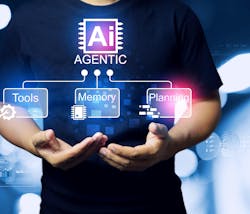Agentic AI, which is an autonomous AI system designed to make decisions without human supervision, is gaining traction in EHS.
Some use cases, as explained in a LinkedIn post from 10xDS, include:
1. Real-Time Hazard Detection and Response
In an industrial setting, hundreds of IoT sensors constantly feed data about air quality, machine vibrations, noise levels, temperatures, and other environmental factors. An AI agent can continuously process this vast, complex stream of inputs and not just monitor threshold violations but recognize evolving patterns that hint at a hazard even before it becomes critical.
For example, a slow rise in chemical vapor concentration might not immediately cross alarm thresholds, but a learning agent could detect that it mimics past incidents. Upon identifying a risk, the AI doesn't simply alert someone; it can initiate actions like sealing off the affected area, activating ventilation systems, or instructing partial evacuation. Over time, it adapts by learning which sensor anomalies led to actual dangers versus false alarms, reducing unnecessary interventions and becoming more predictive.
2. Adaptive Compliance Monitoring and Enforcement
Environmental and safety compliance is a moving target — new regulations emerge, local interpretations vary, and internal policies evolve. An AI agent tasked with compliance monitoring would not just maintain a static checklist; instead, it would constantly ingest updates from regulatory bodies, internal audits, and operating procedures. It then cross-references these requirements against the organization's current conditions, documentation, and operational data.
When it spots a mismatch or anticipates a future compliance risk (such as a maintenance interval about to expire under new guidelines), the agent automatically flags the issue, generates updated audit tools, and suggests corrective actions — sometimes even pre-scheduling inspections or maintenance.
As it operates across different sites or jurisdictions, it adapts by learning the nuances of local law enforcement styles and patterns of non-compliance unique to each environment.
3. Incident Investigation and Root Cause Analysis
After an accident like a chemical spill or worker injury, traditional root cause investigations often involve manual evidence gathering, interviews, and subjective analysis, stretching across weeks. A powerful AI agent can radically compress this timeline. It simultaneously processes diverse data streams: surveillance footage, IoT sensor histories, maintenance logs, workforce schedules, and environmental data.
By applying pattern recognition and causal inference models, the AI can propose multiple hypotheses about what went wrong, rank them by likelihood, and even trace deeper, systemic causes beyond the obvious triggers. It then generates a full incident report and recommends corrective measures — retraining, system.
4. Dynamic Risk Assessment in Operations
In dynamic operational settings like construction sites, mining operations, or oil rigs, risks are constantly shifting due to factors like weather changes, worker fatigue, or equipment malfunctions. Instead of assessing risks at fixed phases of a project, an AI agent performs continuous dynamic risk assessments, recalculating real-time risk profiles based on live data.
It can automatically adjust work permits—for example, revoking a hot work permit if atmospheric conditions become unsafe—and proactively suggest operational changes like slowing down activities, rescheduling tasks, or reinforcing safety measures. By learning from real-world incident patterns, the AI improves its ability to predict and weigh complex, multifactorial risk changes.
5. Environmental Impact Monitoring and Mitigation
For environmental impact monitoring, large industrial sites face ongoing challenges from emissions, chemical runoff, and waste production. An AI agent continuously tracks environmental data across air, water, and soil parameters, predicting potential non-compliance with sustainability goals or regulatory licenses.
When thresholds are breached, it can automatically generate reports for regulatory bodies and recommend corrective actions such as boosting filtration systems, temporarily reducing production output, or altering chemical formulations. Over time, the AI becomes more proficient at keeping environmental impacts low, optimizing operations proactively rather than merely reacting after violations occur.
Agentic AI won’t replace the judgment of EHS professionals, who remain essential at critical validation checkpoints to confirm proposed root causes, controls, barriers, actions," said information consulting company, Wolters Kluwer.
However, with any automatic system, especially one that automates complex processes like risk assessments, incident management, and compliance, there is the concern over mistakes. Which is why, Wolter Skluwer, suggests setting up guardrails, which include:
- Restrictions on which APIs an agent can access
- Controls on the types of queries an agent is allowed to process
- Backup or fallback mechanisms where another agent or a human takes over if the first agent fails
- Human validation checkpoints that require human approval before a task can proceed or be completed
The firm notes that the last safeguard is often referred to as the “human-in-the-loop” approach. They emphasize that, particularly in EHS, a "poor AI decision or hallucination, such as missing a hazard, overlooking a control, or recommending an unsafe procedure, could result in a serious injury or fatality."
They conclude that, "agentic AI won’t replace the judgment of EHS professionals, who remain essential at critical validation checkpoints to confirm proposed root causes, controls, barriers and actions."
About the Author
Adrienne Selko
Senior Editor
Email [email protected]
Adrienne Selko is also the senior editor at Material Handling and Logistics and is a former editor of IndustryWeek.

